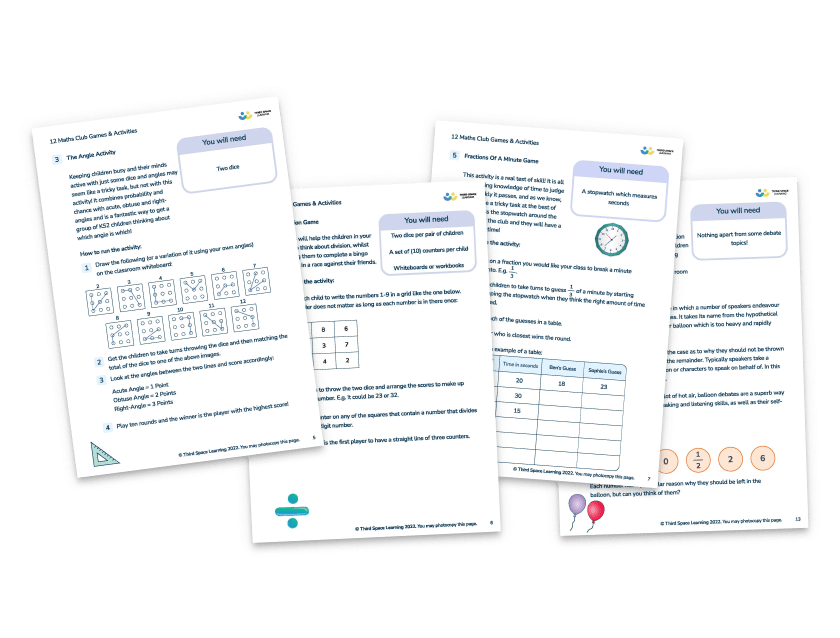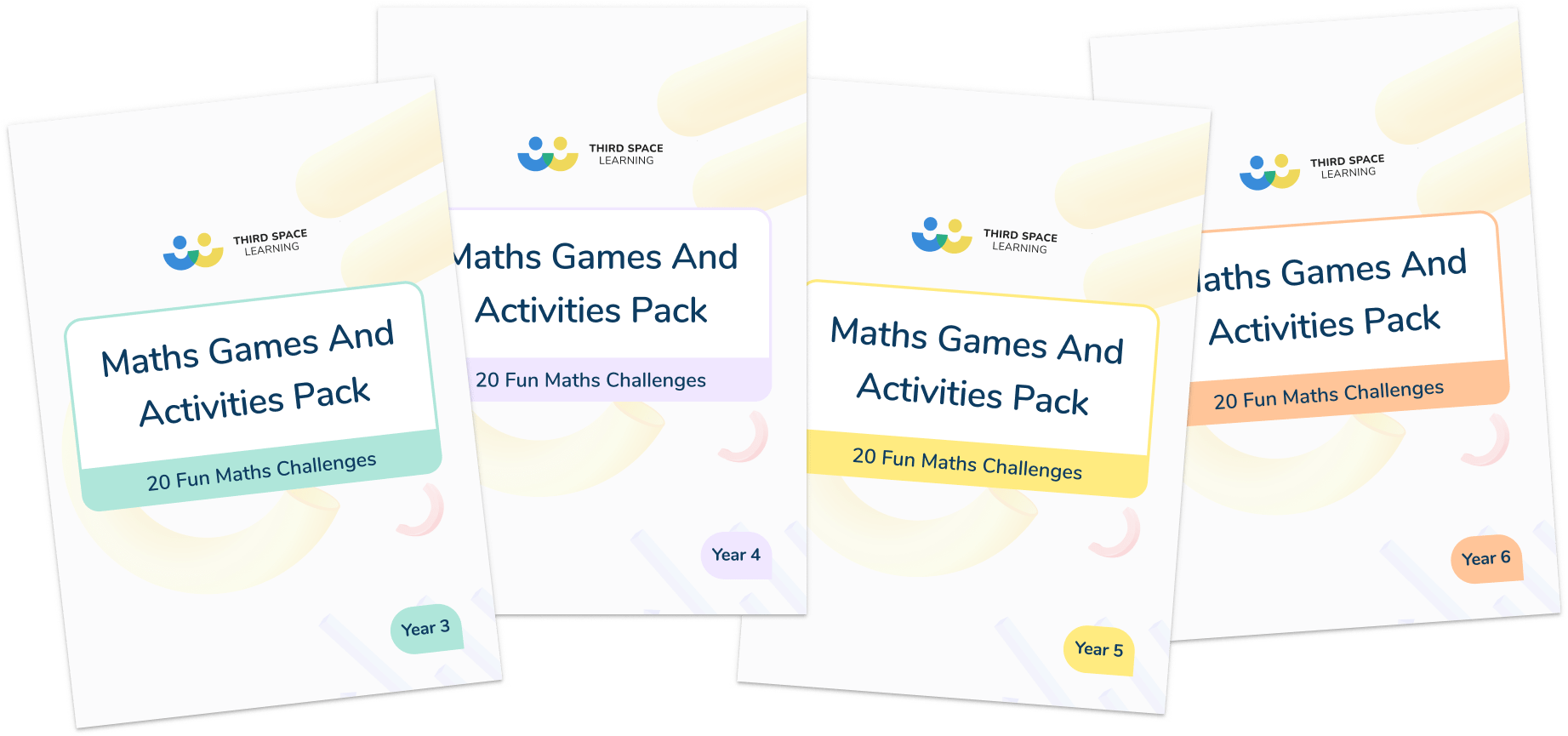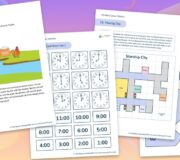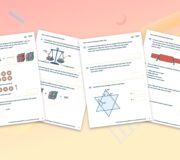25 Fun Maths Games For Kids To Do At Home For Free!
Assistant Headteacher, KS2 leader and parent Emma Johnson shares the best maths games and maths activities for children to play to help develop their mental maths skills.
These educational and popular maths games are suitable for Key Stage 2 children. Most of them are adaptable for Key Stage 1 pupils. Each maths game is an exciting way to practise a wide range of KS1 and KS2 mathematical skills, such as counting, place value, times tables and much much more
How to use these maths games
Life is often rushed and so is teaching the maths curriculum. Use these maths activities in class at the beginning of the day, lesson starters or as a plenary for extra practice and consolidation. You could also set them as homework to engage pupils with enjoyable maths practice at home.
Because everyone’s school timetable or family life is different, we’ve included a range of maths games that everyone can use:
Any time of day: morning starter, over breakfast, on the walk to school or to the park.
No setting up: for when you need a last minute game or are on the go.
Simple and short: play when you have a quick few minutes.
Longer maths games: set as homework the family can enjoy together.
Adaptable: not all pupils learn at the same pace, adapt for KS1 and KS2.
Non-interactive maths games: for those who don’t have access to a device.
Maths games by key stage
If you teach a specific age group, take a look at our collections of games specifically chosen for different key stages at school.
KS2 Maths Games and Activities Pack
A FREE downloadable games and activities pack, including 20 home learning maths activities for KS2 pupils to complete on their own or with a partner.
Download Free Now!3 indoor maths games
Whether it’s the dreaded wet play or setting enjoyable homework during winter, these maths games are suitable for the indoors. They can be played at any time of year and are adaptable for all year groups.
1. Count Down
This is a simple at home version of the TV favourite and can be played with any number of players.
What you need to play:
4 ‘large number’ cards with 25, 50, 75 and 100 on one card each
A set of cards with the digits 1-10 on them, with at least two cards for each digit
How to play:
Set out 4 large number cards (25, 50, 75 and 100) face down and mixed up.
Do the same with the 1 – 10 cards, making sure you have at least 2 cards for each digit.
Players take it in turns to select one of the big number cards or one of the small number cards, until there are 6 cards laid out all together.
Someone who is playing needs to generate a 3-digit number. You could throw a dice, or select cards from a pile each with a digit from 0 to 9.
Once the number has been generated, turn over the six cards and players have to try and make that total using any of the six number cards and any of the four operations.
Each card can only be used once and the winner is the first person to reach the total, or the player who is closest after a set length of time.
Adapt count down for younger children, by choosing the numbers on the cards carefully and have them aim to make a 2-digit number, rather than a 3-digit number.
2. Salute
This simple game is all about encouraging maths talk and vocabulary.
What you need to play:
Two willing participants
Cards numbered 1-10 (these can be made from a sheet of paper)
How to play:
Start with the two players facing each other. Each person selects a card and sticks it on their forehead so the other player can see.
The person leading the game gives a statement, such as what the sum of the two numbers is, the difference between the two or the product of the two etc.
Each player has to work out what number is on their own card based on what is written on the other person’s head and the rule given.
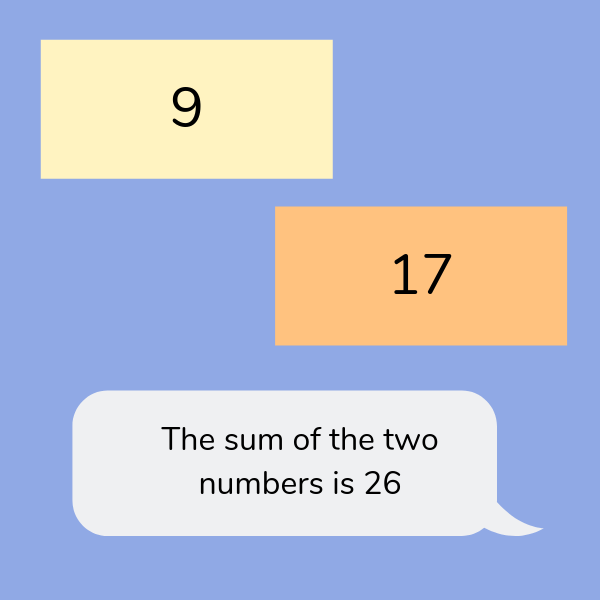
Adapt Salute for older or more able players and use numbers up to 20.
3. Multiplication Bingo
Bingo is a fun game enjoyed by people of all ages. This version puts a mathematical twist on the classic as a way to boost multiplication skills.
What you need to play:
Paper to write numbers down on
How to play:
All players write down 5 numbers which are multiples of a given times table. For example: for the 5 times table, players might write 10, 35, 45, 50 and 60.
A third person can lead the game and call out multiplication questions from the chosen times table.
If a player has the correct answer to the question on their bingo board, they can cross it out. First person to cross out all their numbers is the winner.
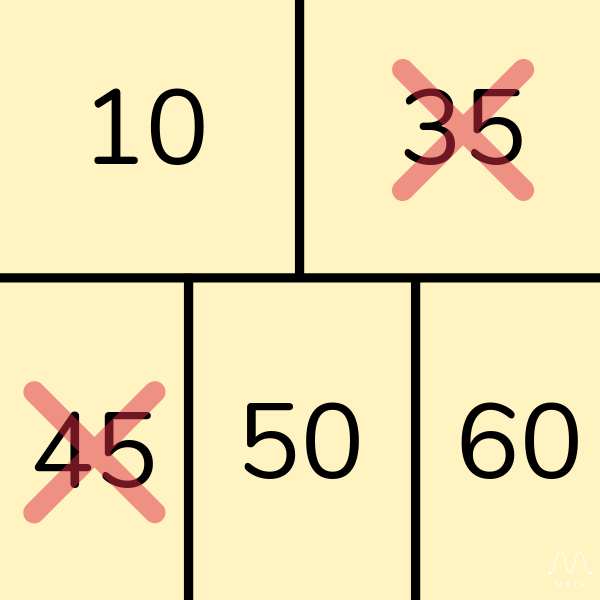
Multiplication Bingo using the 5 times table.
To develop mental maths skills, challenge pupils with the times tables used for multiplication bingo.

Meet Skye, the voice-based AI tutor making maths success possible for every student.
Built by teachers and maths experts, Skye uses the same pedagogy, curriculum and lesson structure as our traditional tutoring.
But, with more flexibility and a lower cost, schools can scale online maths tutoring to support every student who needs it.
Watch Skye in action3 maths games and activities to do at home
One of the best ways to encourage a child to learn about anything is by making it engaging. Here are three fun maths games pupils can play at home.
1. Scavenger Hunt
All children enjoy a scavenger hunt, so why not make one based around maths?
What you need to play
Some creativity
A garden or home full of measurable objects!
How to play:
Give children a grid with some pre-set weights and lengths on. Challenge them to find something in the garden that is approximately 10cm long, or something in the house that weighs 300g, for example.
Gather all of the items they think match the weights and lengths on the card, and check how well they have done with some kitchen scales and a tape measure!
2. The Yes/No Game
This is another simple KS2 maths game loved by children in classrooms across the country! It’s also a good way to practice 2d shapes and 3d shapes.
What you need to play:
A series of cards/pieces of paper
How to play:
Both players put a card on their head. It could have a number on it, a shape etc.
The first player asks a question which can have an answer of ‘yes’ or ‘no’. E.g. ‘Am I odd?’ ‘Am I under 20?’ ‘Do I have 4 sides?’
They keep asking questions until they get the correct answer or run out of turns. You can set this at the beginning.
Players switch over.
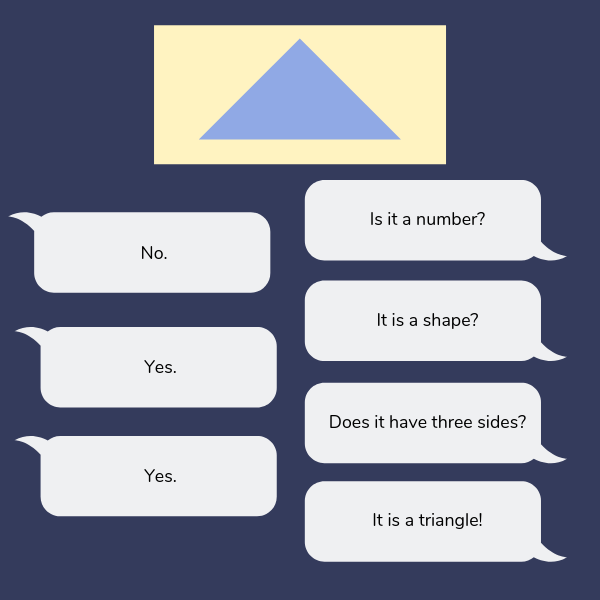
How the Yes/No game could play out using a triangle as the subject.
3. Bang Bang
Bang bang is a great game for practising quick recall facts and developing mental maths skills.
What you need to play:
Two willing mathematicians!
How to play
Two players stand back to back, cowboy shootout style.
Call out a question such as ‘what is 7 x 6?’
The first player to turn, face their opponent, shout ‘bang bang’ and to give the correct answer wins the round.
Repeat until one player reaches the winning amount of points set at the start of the game.
3 hands-on maths games and activities
Doing some hands-on maths activities is a great way to capture children’s full attention when you are doing maths at home, and these games have been created to do just that.
1. Five To One
This game tests children’s reasoning and problem solving skills while bringing an element of competition.
What you need to play:
Cards with maths statements written on them
Two players
How to play:
Player 1 picks a card containing five statements. Each of the five statements provide a clue to the final answer. Statements start with a vague clue and build to an easy clue for the fifth statement.
This player picks a card and reads out the first statement. E.g. ‘This shape has four sides’.
Player two can choose to give the answer and gain the maximum five points, if they are correct. But, they risk scoring zero if they are wrong.
Alternatively, they can choose to hear the next statement for four points. They keep going until they get a question wrong. Or they choose to pass to hear the next question until they get to the final one point question.
2. 24
This is a very simple game that will help children practice their arithmetic skills and develop their mental maths skills.
What you need to play:
A pack of playing cards (no picture cards)
How to play:
Each player picks 4 cards at random from the pile.
They then need to find a way to manipulate the 4 digits using any of the 4 operations (+, -, x, ÷) so the end result is 24 For example, if they chose 4, 7, 8, 8, they could do (7 – (8÷8) x 4 = 24)
If nobody can reach 24, you can make it closest wins!
3. 5 Of A Kind
This is a tricky maths card game that will truly put children’s maths skills and knowledge to the test. It’s a designed for KS2 children – KS1 children may get confused.
What you need to play:
5 sets of cards numbered 2-9
How to play:
The first player picks a card numbered from 2 – 9.
They then collect another 4 cards with the same number as the first, so they have 5 cards with the same number.
The aim is to use one or more of the five cards to make each digit between one and ten.
For example, the player chose a 5. They would then need to use one or more of the cards to find the answer 1, 2, 3…… To make 1, they could do 5 ÷ 5, to make 2 they could do (5 ÷ 5) + (5 ÷ 5) etc….
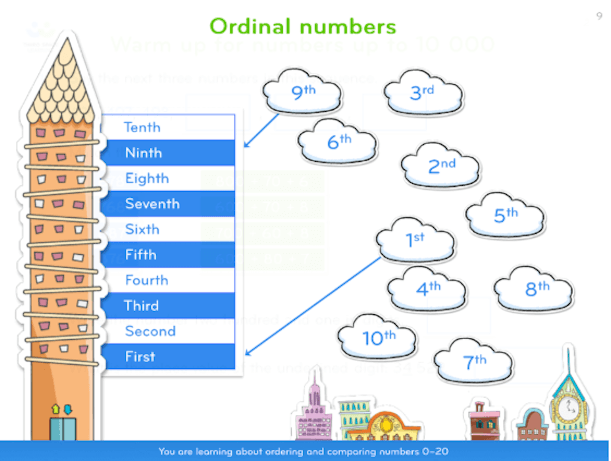
An example slide from a Third Space lesson on ordinal numbers; Pupils work through these type of activities with Skye, the AI tutor, to help practise and embed mathematical knowledge.
3 outdoor maths games and activities
The great outdoors and maths go hand in hand. These outdoor activities should serve as inspiration about how you can help children learn maths while outdoors!
1. Life Size Board Games
Board games are a fun whether played online or in real life. But have you ever thought about becoming part of the board game?
For outside maths learning, you can make a life size board game and become the characters in the game.
What you need to play:
Paper plates (or even just sheets of paper will do)
A large dice (or a cube shaped box which can be made into a dice)
A dose of creativity!
How to play:
Use paper plates to make the board game squares. If you don’t have access to a large dice, a cube shaped box will do instead.
The board games you play will vary depending on children’s age. With younger children, number the plates to encourage counting or learning their number bonds. For older children, you could have times tables or harder maths questions to answer as they move round the board.
2. Multiplication Hopscotch
Everyone knows how to play hopscotch. Introducing maths into the mix can turn this traditional playground game into a quick fire questions for multiplication.
What you need to play:
Chalk
How to play:
Using chalk, draw out hopscotch squares on the ground and in each square, write either multiples or multiplication facts.
Each person then hops, skips and counts the multiples at the same time. This is a good way to help those multiplication tables stick.
Alternatively call out a quick fire question and ask pupils to land on the answer.
Adapt for upper KS2 by using prime numbers or square numbers.
3. Telling The Time Activity
Often, children find telling the time difficult. It’s an abstract concept. This game will help children tackle telling the time.
What you need to play:
Chalk
How to play:
Draw a clock on the ground with chalk.
Call out a time.
Children make the hands of the clock. They could show just the hour or minute hands by lying straight, or they could use their body to make the hour and the minute hands, with their legs as the minute hand and their torso as the hour hand.
More fun maths for kids
3 fun maths dice games to play
Every classroom and most homes own a dice. Most board games coming prepackaged with a dice, re-purpose them for these dice games.
If you can’t find one, make one – just draw out the 6 sides of a cube, stick them together, and you’re ready to go. Try to get your opposite sides adding up to 7 as on the real thing.
1. Skunk
This is perfect to teach children all about probability. Whilst it seems like it would be easy to win, children will soon find out that this isn’t the case.
What you need to play:
Two dice
A sheet of paper
How to play
Write the word skunk and separate each letter into a different column on a sheet of paper. Each letter of the word ‘skunk’ represents a different round of the game.
The first player rolls a pair of dice and works out the total of the two dice. The total is written in the S column. If they roll a one they score zero.
Once they have their first score under the letter ‘S’, they have to make the decision to either stop and take that score as their total for the game or roll again and hope they roll higher to add to the total from the first round.
If they roll a one in the second round, play stops and the player takes the score from the first round as their total. The risk a player takes in throwing again, is if two ones are thrown, all the points for the game are wiped and the player scores zero.
2. The Pig Dice Game
This is similar to the skunk game but there only needs to be one player and one dice. However, even with only one dice things will still get tense!
What you need to play:
One die
A sheet of paper
How to play:
Throw the die and record the number that they roll. As long as it isn’t a one, the player can roll again and add the number to their total.
After each throw, the player has to decide whether to throw again or keep the points they’ve scored. If a one is thrown at any point, the player loses all the points scored so far.
The aim is to reach exactly 100
3. Triangle Tower
This is a great way to test children’s times tables skills. It only takes two minutes to set up!
What you need to play:
Two dice
A sheet of paper
Counter or coins
How to play:
Draw a triangle made from squares, with four on the bottom up to one at the top.
Each player chooses 10 numbers from the products table (1, 2, 3, 4, 5, 6, 8, 9, 10, 12, 15, 16, 18, 20, 24, 25, 30, 36). This is simply all of the possible options you can get when multiplying the numbers between 1 and 6 together.
Write one number in each of the ten triangles from the product table results above.
The first player then rolls 2 dice and multiplies the two numbers together. If they have the product of the two numbers written on their tower, they can then cover it with a counter.
The winner is the first player to cover all their numbers in the tower.
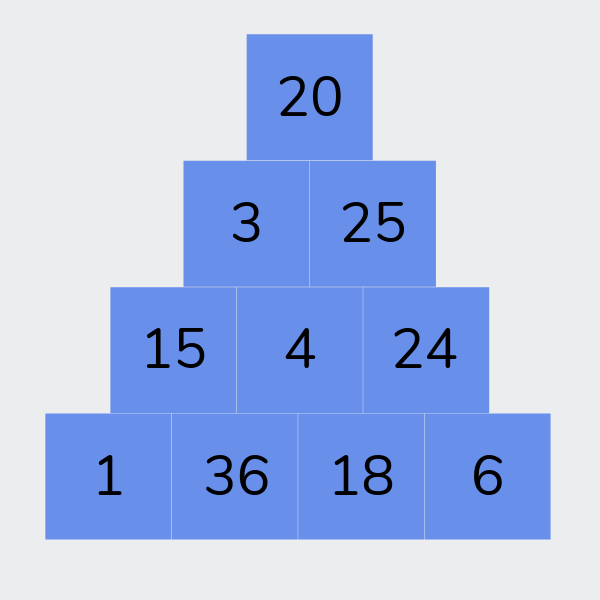
Game extension idea
The game can include more challenging multiplication calculations by changing the numbers on the dice.
If one has 1-6 and the second has 7-12, the numbers each player has to choose from are (7, 8, 9, 10, 11, 12, 14, 16, 18, 20, 21, 22, 24, 27, 28, 30, 32, 33, 35, 36, 40, 42, 44, 45, 48, 50, 54, 55, 60, 66 and 72)
Alternatively, both dice marked with 7 – 12 would give the products 49, 56, 63, 64, 70, 72, 77, 80, 81, 84, 88, 90, 96, 99, 100, 108, 110, 120, 121, 132 and 144.
READ MORE: The best times tables games for KS1 and KS2
3 fun maths card games for kids to play
Along with dice, playing cards are one of the most versatile and underused maths resources that can be found in most vlassrooms and homes.
1. The Biggest Number
Place value is a crucial skill for children to grasp during primary school, and this simple card game helps them develop these skills visually.
What you need to play:
One place value grid (drawn onto a piece of paper)
A deck of playing cards
How to play:
Each player draws a place value grid, with an agreed number of places. E.g. Thousands, hundreds, tens and ones.
Use a deck of cards 2-10, Ace and picture cards. 2-10 are worth their digit, Aces are worth 1 and picture cards are worth 0.
Players take turns to draw a card from the pile, and chooses which column to record the number in. The winner is the person to have the biggest number recorded at the end of the game.
If you like this check out our other amazing place value games.
2. First To 100
This is a quick and simple game to get children practising their maths skills in a fun and exciting way!
What you need to play:
A deck of playing cards
A sheet of paper
How to play:
Shuffle a pack of cards and place face down. Each player takes one card and turns it over in front of them.
Record the number on the card (Ace is worth 1 and picture cards are worth 10).
Each player then takes a second card and adds the number to the first card recording it on the paper.
Keep taking cards until the first person reaches 100.
Game extension idea
A variation on this game can be to start at 100 and keep subtracting until someone gets down to zero.
For older children, instead of adding the cards together, they can be multiplied each time, with the winner being the first to reach 1000.
3. Wild Jack
This is a fast paced card game for two or more players, where all eyes will be on the Jacks in the pack.
What you need to play:
A deck of cards
How to play:
Other than the Jacks, remove all of the picture cards from a deck. Jacks are ‘wild cards’ and can be used at any time to represent any number from 1 – 10.
The aim is to reach the target number. To make the target number, shuffle the pack and turn over the top two cards. If either are a 10 or joker, put them to the bottom. The 2 cards turned over make the target number. For example, if you turn over the 5 of hearts then the 2 of diamonds, your target number is 52.
Each player has 5 cards set out face up. Players then add, subtract, multiply and divide to try to reach the target number. If a player reached the target using all 5 cards they score 10 points, if it is made using less than 5 cards, they score 8 points.
3 best pen and paper maths activities
There is no need for fancy equipment when it comes to these maths game. A pen or pencil and a few sheets of paper are all you need.
1. Battleships
This is a KS2 maths game that most people will be familiar with, but it just so happens to be fantastic practice for coordinates.
What you need to play:
Some sheets of paper
Pens or pencils
How to play:
Each player draws out a grid with A – J along the bottom and 1 – 10 up the side.
They then plot ships of various sizes on the grid by colouring in the squares:
One ship five squares long (the aircraft carrier)
One ship four squares long (the battleship)
Two ships three squares long (the cruiser and submarine)
One ship two squares long (the destroyer)The first player ‘shoots’ by calling out a grid reference, e.g. B3. If it hits an empty square, the other player shouts, ‘miss!’ whilst the first player draws a cross, but if it hits a square with a ship in it, they have to shout ‘hit’ and the other player draws a dot. Each player keeps track of their hits and misses on a separate grid.
Once a player hits all the squares for a ship, the ship then ‘sinks’. The winner is the one to sink all the other person’s ships first.
2. Multiplication 4 In A Row
This game makes learning multiplication facts fun.
What you need to play:
Sheets of paper
Counters or coins
Specific times tables e.g. multiples of 2, 5 or 10
How to play:
Each player needs a set of coloured counters or different coins (2ps vs 10ps as an example).
Make a grid containing the answers to the times tables chosen and a set of cards with the multiplication questions.
Each player takes it in turns to pick a card, answer questions and then cover the answer with their counter. The first player to cover four in a row is the winner.
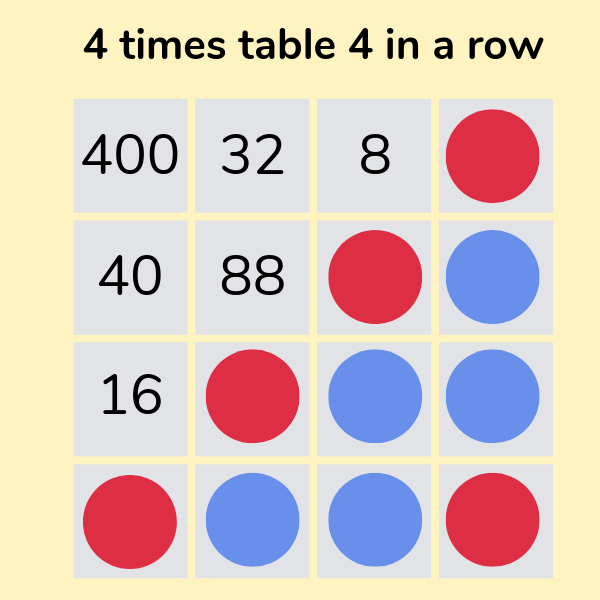
3. Dots And Boxes
This game can be played by drawing dots on a page, but it is easier to download square dot paper and print it out.
What you need to play:
A sheet of dotted paper
A pen or pencil
How to play:
Player one draws a line to join one of the dots to another of the dots, the next player then does the same.
This continues until one player manages to join the lines to make a box. They write their initial in the box and get to take another go. Once they are no longer able to complete a full box, it goes back to the other player.
The winner is the person who has their initial in the most boxes.
4 maths games for on the go
You can put all shouts of “Are we there yettttt…..” to bed with these four simple and fun maths games children can play in the car or on a school trip.
1. Creative Counting
Simple counting games are great for younger children.
Ask them to count what they can see, for example: lorries, cars, animals.
Make them more challenging by changing how many points each is worth, so children could count up in twos or threes etc…
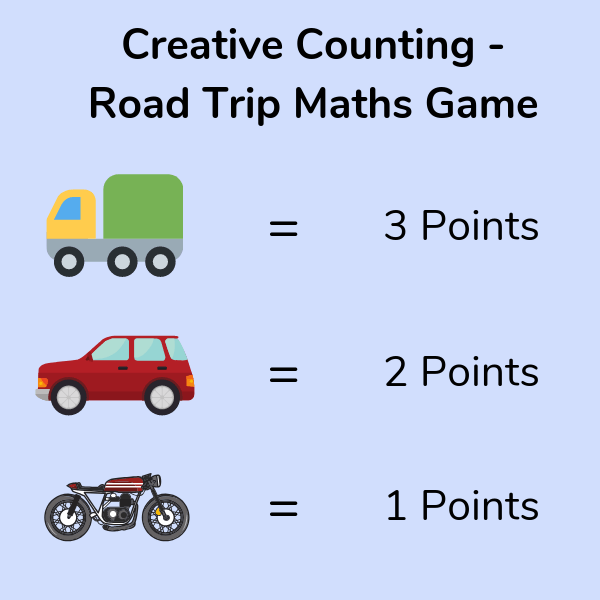
2. Guess My Number
This game can be adapted for any age.
Think of a number for the children to guess.
Players have to ask questions that have a yes or no answer to identify the number.
Give younger children a range within which the number falls, they call out a number and are given ‘higher’ or ‘lower until they reach it.
A more challenging version of the game would be to give players a range of clues, e.g. ‘It’s an even number’. ‘it’s divisible by 2, 5, 10 and 25′, ‘it’s equal to two quarters’.
3. Guess My Rule
Players give a number whilst the person leading the game applies a mystery rule and tells the players what the new number is.
For example: If the rule is multiply by 10, one player would give the number, e.g. 37 and they would be answered once the rule has been applied. In this instance, they would be answered 370.
4. 21
This is a fun strategy game, played with two or more players, who take turns to count to 21 from 1.
Each player can call out one, two or three consecutive numbers, before it moves to the next player to carry on counting up.
The player who ends up saying ‘21′ is out of the game.
The game then continues, counting back up from 1 to 21, until there is only one person left. They are the winner.
Maths games are all around us!
There are of course many more simple maths games which can be enjoyed in the classroom or at home, and they are only limited by your creativity.
Hopefully, these ideas will give you a starting point, but why not get really creative and create some games of your own!
DO YOU HAVE STUDENTS WHO NEED MORE SUPPORT IN MATHS?
Skye – our AI maths tutor built by teachers – gives students personalised one-to-one lessons that address learning gaps and build confidence.
Since 2013 we’ve taught over 2 million hours of maths lessons to more than 170,000 students to help them become fluent, able mathematicians.
Explore our AI maths tutoring or find out about school tutors for your school.
